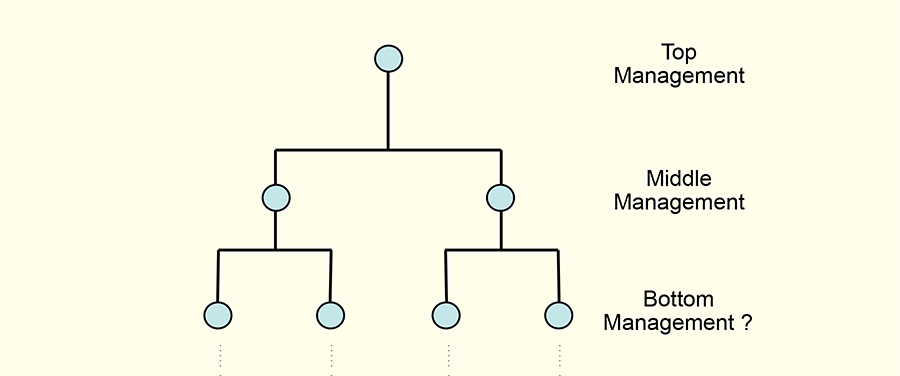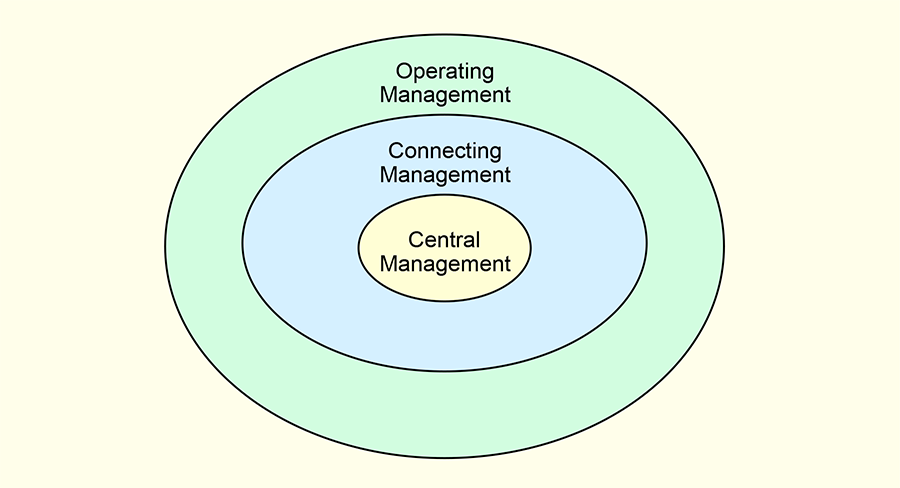Why do we say “Top Management” yet never “Bottom Management”?
19 March 2015We say “top management” in our organizations. And “middle management” too. So why don’t we say “bottom management”? After all, these managers know full well that if one manager is at the top and others are in the middle, they must be on the bottom.
This doesn’t tell us about the bottom; it tells us about the top: that it’s no more than a metaphor, and a silly one at that. On top of what?
-
On top of the chart? To be sure. (See it below.) But put that chart on a table and you will see top management for what it is: no higher than anyone else. Why are we so obsessed with hierarchy—with who sits on top of whom? Is that all there is to an organization? You would think so if you tried to find any other graphic representation of the place.

-
Usually on top of the building too. Is this for a better view? From up there, top managers can see everything in general and nothing in particular. Bear in mind that the bottomest of bottom managers in Denver sit thousands of feet higher than the topest of top managers in New York.
-
Well then, how about on top of what’s going on in the organization? Certainly not. Perceiving oneself perched on top of an organization is the worst way to understand what’s happening inside of it. Say “top” and we picture someone hovering over the place, as if on some sort of cloud, far removed from all those people who make the products and deliver the services.
So how about this? We get rid of top management (the name I mean). Instead we call it central management, as shown in the inner circle of the figure below. This suggests that it is essential but not superior, still removed from the operations, but in this depiction evidently so.

In the outer circle, all around the organization, we put those managers who face out to the world, in closest touch with the customers and operating employees. So let’s call them operating managers.
And between the central managers and the operating managers are the connecting managers. They still translate between the center and the operations, but also carry the best ideas generated in the operations to the center. No longer, like Sisyphus, do they have to do this uphill!
Thus, instead of seeing middle mangers as drains on the organization—lost somewhere in the middle, to get rid of at the first opportunity (it’s called “downsizing”: think bloodletting)—these connecting managers can be seen as essential players in the creation of constructive change. In fact, the best of them, with a broad enough perspective to appreciate the big picture yet grounded enough to help develop it, can turn out to be key strategists in the organization.
To conclude, if you would like to do some worthwhile downsizing in your organization, begin with the bloated vocabulary of “top management”. Stop using it. That way you can cease looking up and down, to figure out who is more and less important, and instead look around, at all your valued colleagues.
© Henry Mintzberg 2015 HM teaches in the Managers’ mba—it’s about managing by action, not Administering Businesses. (See managersmba.org.)
For related TWOGs: On the difference between an Organization and a Reorganization, on how strategic ideas can come from the operations. On engaging management.